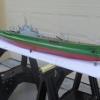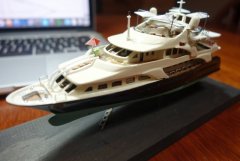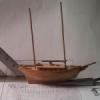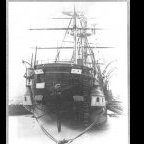Supplies of the Ship Modeler's Handbook are running out. Get your copy NOW before they are gone! Click on photo to order.
×
-
Posts
3,462 -
Joined
-
Last visited
Reputation Activity
-
 amateur got a reaction from Piet in Smit Rotterdam by Sjors - Billing Boats - 1:75 - Sea tug
amateur got a reaction from Piet in Smit Rotterdam by Sjors - Billing Boats - 1:75 - Sea tug
Hi John,
that is deceptive: he has quite a number if things to do. Railing stanchions for instance. But, you’re right: less work than rigging ratlines for a three-masted man-of-war.
Jan
-
 amateur reacted to flying_dutchman2 in Eight Sided Drainage Mill by flying_dutchman2 - FINISHED - scale 1:15 - Achtkante Poldermolen
amateur reacted to flying_dutchman2 in Eight Sided Drainage Mill by flying_dutchman2 - FINISHED - scale 1:15 - Achtkante Poldermolen
Finished the mill, except for the sails which I still need to dye dark brown. Once the weather is warm (several months from now) I will revisit this build with outside pictures. For now, here are some shots of the finished mill.
Crooked brick work. Will be improved with me next mill.
Shutters and window. Another window with shutters on the opposite side.
Door and step. There is another door and steps on the opposite side.
Four small windows. The imitated gray thatch has some yellow ochre painted on to give it some contrast.
Wheel with rope.
The flag is painted with acrylic. I think it will deteriorate after the first rain. Need to make something with linnen.
The beard.
Letters were carved out and painted red. It says "Anno 1992" "Stichting Molens". Not all the text fitted on the 'beard'. Did not have a template for smaller letters.
Color coded vanes. It is not visible, except if you look closely. It is coded so I know which vane goes where on the copper tubing.
Copper tubing without the vanes.
My nosey cat.
That completes the build. Thank you all for following, giving advice and uploading various beautiful pictures of the different mills the Netherlands has to offer
Marcus
-
 amateur reacted to KORTES in SPERWER by KORTES - FINISHED - 1:30 scale - Friescheboeier Yacht
amateur reacted to KORTES in SPERWER by KORTES - FINISHED - 1:30 scale - Friescheboeier Yacht
Mastkoker assembled
-
 amateur got a reaction from Jack12477 in SPERWER by KORTES - FINISHED - 1:30 scale - Friescheboeier Yacht
amateur got a reaction from Jack12477 in SPERWER by KORTES - FINISHED - 1:30 scale - Friescheboeier Yacht
HiVossie,
it is even weirder: the botteloef is not a bowsprit in a normal way. Therefore, next to this botteloef (and its extension 'opsteker'), these ships often had a separate boom as bowsprit.
the botteloef is intended to have the fore sail forward as much as possible, as that improves sailing qualities. (And that is also the reason that some owners had the botteloef extended using such an opsteker: getting the fore sail even further forward. )
Jan
-
 amateur got a reaction from BETAQDAVE in Cleats
amateur got a reaction from BETAQDAVE in Cleats
Hi Grandpa,
I guess that very much depends on the scale and period you are building.
wooden cleats can be done in various ways: miling a strip of wood into the outer profile you need, and sawing off cleats in the width you need.
or just forming them one by one froma strip that has the correct width and thickness.
metal cleats, I never did one, but I guess that there are also various ways....
Jan
-
 amateur got a reaction from Canute in Cleats
amateur got a reaction from Canute in Cleats
Hi Grandpa,
I guess that very much depends on the scale and period you are building.
wooden cleats can be done in various ways: miling a strip of wood into the outer profile you need, and sawing off cleats in the width you need.
or just forming them one by one froma strip that has the correct width and thickness.
metal cleats, I never did one, but I guess that there are also various ways....
Jan
-
 amateur got a reaction from GrandpaPhil in Cleats
amateur got a reaction from GrandpaPhil in Cleats
Hi Grandpa,
I guess that very much depends on the scale and period you are building.
wooden cleats can be done in various ways: miling a strip of wood into the outer profile you need, and sawing off cleats in the width you need.
or just forming them one by one froma strip that has the correct width and thickness.
metal cleats, I never did one, but I guess that there are also various ways....
Jan
-
 amateur got a reaction from mtaylor in Ligurian Tartane by Javier Baron - FINISHED - scale 1:200
amateur got a reaction from mtaylor in Ligurian Tartane by Javier Baron - FINISHED - scale 1:200
Thanks for the explanation!
-
 amateur got a reaction from Omega1234 in Ligurian Tartane by Javier Baron - FINISHED - scale 1:200
amateur got a reaction from Omega1234 in Ligurian Tartane by Javier Baron - FINISHED - scale 1:200
Thanks for the explanation!
-
 amateur reacted to Javier Baron in Ligurian Tartane by Javier Baron - FINISHED - scale 1:200
amateur reacted to Javier Baron in Ligurian Tartane by Javier Baron - FINISHED - scale 1:200
Making of sail:
I cut to bias strips of fabric of the desired width to imitate the sail cloths that make up the sails in reality.
I stick the strips with textile glue, with a minimum overlap between them.
I cut the sails to the size and shape needed for the model, I make the reef bands with a thin strip of fabric that I stick in its position.
If the sail has patches in the corners, I hit them before the tablings.
With strips of fabric of a minimum thickness I make the tablings, which are then stuck on the edges of the trimmed sail (on both sides). I stick a thread around the sail to make the bolt rope, leaving a loop in the corners to make the clue ropes. Finally, I put the reefs in the number and position that is required in the corresponding positions of the reef bands.
Javier
-
 amateur got a reaction from BETAQDAVE in Ligurian Tartane by Javier Baron - FINISHED - scale 1:200
amateur got a reaction from BETAQDAVE in Ligurian Tartane by Javier Baron - FINISHED - scale 1:200
Wow, it takes some time to realize the size of this ship.
Can you tell how you made the sails? they lookvery convincing.
Jan
-
 amateur got a reaction from mtaylor in Ligurian Tartane by Javier Baron - FINISHED - scale 1:200
amateur got a reaction from mtaylor in Ligurian Tartane by Javier Baron - FINISHED - scale 1:200
Wow, it takes some time to realize the size of this ship.
Can you tell how you made the sails? they lookvery convincing.
Jan
-
 amateur reacted to Javier Baron in Ligurian Tartane by Javier Baron - FINISHED - scale 1:200
amateur reacted to Javier Baron in Ligurian Tartane by Javier Baron - FINISHED - scale 1:200
The tartana is finished. I have followed closely the monograph of the tartana Gemma (ANCRE), of Franco Fissore, although I have allowed myself some licenses because of the small scale. One of the aspects in which I have been guided totally by the monograph is in which the model has been rigged, with the jibs to starboard in a boom especially armed for it.
I hope the result will be to your liking, because I have really enjoyed doing this
-
 amateur got a reaction from popeye the sailor in Smit Rotterdam by Sjors - Billing Boats - 1:75 - Sea tug
amateur got a reaction from popeye the sailor in Smit Rotterdam by Sjors - Billing Boats - 1:75 - Sea tug
Hi John,
that is deceptive: he has quite a number if things to do. Railing stanchions for instance. But, you’re right: less work than rigging ratlines for a three-masted man-of-war.
Jan
-
 amateur got a reaction from cog in Smit Rotterdam by Sjors - Billing Boats - 1:75 - Sea tug
amateur got a reaction from cog in Smit Rotterdam by Sjors - Billing Boats - 1:75 - Sea tug
Hi John,
that is deceptive: he has quite a number if things to do. Railing stanchions for instance. But, you’re right: less work than rigging ratlines for a three-masted man-of-war.
Jan
-
 amateur got a reaction from Rik Thistle in Varyag 1901 by Valeriy V - FINISHED - scale 1:75 - Russian Cruiser
amateur got a reaction from Rik Thistle in Varyag 1901 by Valeriy V - FINISHED - scale 1:75 - Russian Cruiser
That is quite impressive!
Jan
-
 amateur got a reaction from mtaylor in King of the Mississippi by Anna - Artesania Latina - 1:80
amateur got a reaction from mtaylor in King of the Mississippi by Anna - Artesania Latina - 1:80
Hi Anna,
Nice going!
Whether to use paint, lacquer or oil is largely your own choice.
I prefer paint/lacquer (just the normal smallest tin of non-coloured 'histor blanke lak' sold by Gamma )
that way the wwood is protected. I never tried oil. From what I have seen here: oil goes into the wood, lacquer remains on top. So any errors with (too much) glue tend to show up with oil, and lesswith lacquer).
Paint is another story: some like the wood to show, and use different types of wood to have variation in colours. Other refer to the ships that are modelled, and that are never unpainted, and therefore use paint to resemble to original as best as possible. Up to youo whichever gang you belong (and you can always turn to the others ). When using paint, you can use the standard stuff from the home deco, but it works easier with modelling paint. tamya and Humbrol sell small tins waterbased enamel/paint in a broad range of colours. Originally for plastics, they stick very well to wood and metal as well.
I guess Shamrock still sells them.
In al cases, it needs some ahead planning: you have to paint when everything is still reachable. Nothing so annoying a a spot you can see, butnot reach with yourbrush.
But on the other hand, glue will not hold on paint, lacquer and oil. So, don't put the stuff on too early.
Jan
-
 amateur got a reaction from Mirabell61 in Varyag 1901 by Valeriy V - FINISHED - scale 1:75 - Russian Cruiser
amateur got a reaction from Mirabell61 in Varyag 1901 by Valeriy V - FINISHED - scale 1:75 - Russian Cruiser
That is quite impressive!
Jan
-
 amateur got a reaction from popeye the sailor in Varyag 1901 by Valeriy V - FINISHED - scale 1:75 - Russian Cruiser
amateur got a reaction from popeye the sailor in Varyag 1901 by Valeriy V - FINISHED - scale 1:75 - Russian Cruiser
That is quite impressive!
Jan
-
 amateur got a reaction from Keith Black in SPERWER by KORTES - FINISHED - 1:30 scale - Friescheboeier Yacht
amateur got a reaction from Keith Black in SPERWER by KORTES - FINISHED - 1:30 scale - Friescheboeier Yacht
HiVossie,
it is even weirder: the botteloef is not a bowsprit in a normal way. Therefore, next to this botteloef (and its extension 'opsteker'), these ships often had a separate boom as bowsprit.
the botteloef is intended to have the fore sail forward as much as possible, as that improves sailing qualities. (And that is also the reason that some owners had the botteloef extended using such an opsteker: getting the fore sail even further forward. )
Jan
-
 amateur got a reaction from Canute in Varyag 1901 by Valeriy V - FINISHED - scale 1:75 - Russian Cruiser
amateur got a reaction from Canute in Varyag 1901 by Valeriy V - FINISHED - scale 1:75 - Russian Cruiser
That is quite impressive!
Jan
-

-
 amateur got a reaction from mtaylor in Deck gun cannons
amateur got a reaction from mtaylor in Deck gun cannons
Doris did
Now I need to think: where.....
Jan
-
 amateur got a reaction from mtaylor in How to establish the lenght of a deck plank?
amateur got a reaction from mtaylor in How to establish the lenght of a deck plank?
Strict rules on plank length, shift-patterns etc. were not around when the Revenge was build. Archeological evidence suggest there is quite a margin to fudge
-
 amateur got a reaction from mtaylor in Varyag 1901 by Valeriy V - FINISHED - scale 1:75 - Russian Cruiser
amateur got a reaction from mtaylor in Varyag 1901 by Valeriy V - FINISHED - scale 1:75 - Russian Cruiser
That is quite impressive!
Jan












